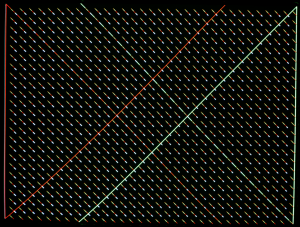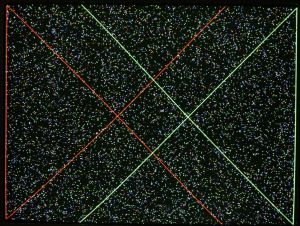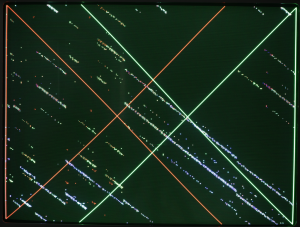Just to make sure the protocol is okay, a small BASIC program sends six frames of data per pixel representing X coordinate, Y coordinate and Color. It’s easy to convert the values into 6 bit wide words:
Xhigh = INT(X/64) : Xlow = X-XH*64 ( X [0..639] )
Yhigh = INT(Y/64) : Ylow = Y-YH*64 ( Y [0..479] )
Chigh = INT(C/64) : Clow = C-CH*64 ( C [0..255] )
Data is sent in the order Xhigh, Xlow, Yhigh, Ylow, Chigh, Clow. There is no function identifier transfered to keep it as simple as possible for the moment. Therefore the CHRE executes always the SetPixel(x,y,c) function to draw a single pixel at the coordinates x,y in the color c.
The following image shows some red and green lines that are coded into the CHRE firmware. This test pattern is written to the framebuffer when the CHRE is ready to receive serial data. The colorful small lines that are evenly spread are drawn pixel by pixel of the received data packets:
I’m very happy with the result. No missing pixels, no pixels out-of-line.
It took ages to render this image at a rate of 5 to 6 pixels per second. That was to be expected, though. BASIC is way too slow for this task. For the final version I’ll write all communication related code in Assembler.
By the way: Have you ever wondered why some of your BASIC games were pretty predictable despite the fact you used the random number function? Well, I did back in the day! The next picture shows random pixels:
And this picture shows random pixels, too:
Both BASIC programs were identical, with the exception of the parameter for the random number function: RND(1) vs. RND(0)
All necessary information was in the manual of the 8xxx series, but as far as I remember we never had a PET 2001 manual in school. Maybe our teacher hid the manual to hold all the cards? Pointless! 🙂


